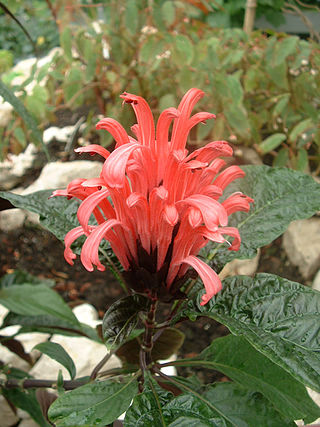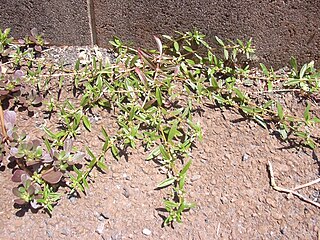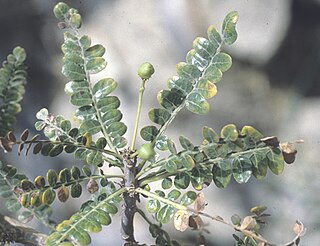
Acanthaceae is a family of dicotyledonous flowering plants containing almost 250 genera and about 2500 species. Most are tropical herbs, shrubs, or twining vines; some are epiphytes. Only a few species are distributed in temperate regions. The four main centres of distribution are Indonesia and Malaysia, Africa, Brazil, and Central America. Representatives of the family can be found in nearly every habitat, including dense or open forests, scrublands, wet fields and valleys, sea coast and marine areas, swamps, and mangrove forests.

Pandanus is a genus of monocots with about 578 accepted species. They are palm-like, dioecious trees and shrubs native to the Old World tropics and subtropics. Common names include pandan, screw palm and screw pine. They are classified in the order Pandanales, family Pandanaceae.

Justicia is a genus of flowering plants in the family Acanthaceae. It is the largest genus within the family, with over 900 accepted species. They are native to tropical to warm temperate regions of the Americas, India, and Africa. The genus serves as host to many butterfly species, such as Anartia fatima. Common names include water-willow and shrimp plant, the latter from the inflorescences, which resemble a shrimp in some species. The generic name honours Scottish horticulturist James Justice (1698–1763). They are closely related to Pachystachys.

Boswellia is a genus of trees in the order Sapindales, known for its fragrant resin. The biblical incense frankincense is an extract from the resin of the tree Boswellia sacra, and is now produced also from B. frereana. Boswellia species are moderate-sized flowering plants, including both trees and shrubs.

Commiphora is the most species-rich genus of flowering plants in the frankincense and myrrh family, Burseraceae. The genus contains approximately 190 species of shrubs and trees, which are distributed throughout the (sub-) tropical regions of Africa, the western Indian Ocean islands, the Arabian Peninsula, India, and South America. The genus is drought-tolerant and common throughout the xerophytic scrub, seasonally dry tropical forests, and woodlands of these regions.

Barleria is a genus of plants in the family Acanthaceae. It includes 303 species native to the tropics and subtropics, including the Americas from Mexico to northern South America, sub-Saharan Africa, Egypt and the Arabian Peninsula, the Indian subcontinent, Indochina, southern China and Taiwan, parts of Malesia, and New Guinea.

Oldenlandia is a genus of flowering plants in the family Rubiaceae. It is pantropical in distribution and has about 240 species. The type species for the genus is Oldenlandia corymbosa.

Allophylus is a genus within the plant family Sapindaceae. It includes 211 species with a pantropical distribution.
Allophylus rubifolius var. rhusiphyllus is a variety of flowering plant in the family Sapindaceae. It is a shrub or tree native to northeastern Somalia and the Socotra Archipelago of Yemen. In the Socotra Archipelago it is a fairly common tree in submontane woodland.

Anisotes is a genus of Afrotropical plants in the family Acanthaceae. The genus is morphologically similar to Metarungia, from which it differs mainly in the dehiscence of the fruit capsule, and the nature of the placenta. Placentas remain attached to the inner surface of fruit capsules in Anisotes.

Ballochia is a genus of flowering plant in the family Acanthaceae. It is endemic to Socotra. It contains the following species:

Blepharis is a genus of plant in family Acanthaceae. It contains around 128 species found in seasonally dry to arid habitats from Africa through Arabia to Southeast Asia. In section Acanthodium, there are 13–15 species that use the C4 carbon fixation pathway. Phylogenetic analysis suggests that this pathway evolved up to three times independently in the genus over the last five million years.

Boswellia socotrana is a species of plant in the Burseraceae family. It is endemic to Socotra, Yemen. Its natural habitats are subtropical or tropical dry forests and subtropical or tropical dry shrubland.

Rhododendron selense (多变杜鹃) is a rhododendron species native to southwestern Sichuan, eastern Xizang, and western Yunnan in China, where it grows at altitudes of 2,700–4,000 m (8,900–13,100 ft). It is an evergreen shrub that grows to 1–2 m (3.3–6.6 ft) in height, with leaves that are oblong-elliptic or obovate to elliptic, 4–8 by 2–4 cm in size. The flowers are pink.

Rhododendron eudoxum is a species of flowering plant in the Ericaceae family. It is native to the bamboo forests of southeast Xizang and northwest Yunnan, China, where it grows at altitudes of 3,300–4,300 m (10,800–14,100 ft). It is a dwarf shrub that typically grows to 30–120 cm tall, with leathery leaves that are long-elliptic to oblong-obovate in shape, and 2.3–3 cm (0.9–1.2 in) long and 0.8–1.4 cm (0.3–0.6 in) wide. Its flowers are red. It is placed in section Ponticum.

Huberantha is a genus of plants in the family Annonaceae and tribe Miliuseae. It is distributed in Australia, tropical Asia, East Africa and some Pacific islands. Tanawat Chaowasku named the genus "Huber's flowers" in honor of the German botanist Herbert Huber and to highlight its flowers as a distinguishing feature of the genus. A number of species have been moved here from the genus Polyalthia.
Duosperma is a genus of flowering plants belonging to the family Acanthaceae.
Megalochlamys is a genus of flowering plants belonging to the family Acanthaceae.
Allophyllus rubifolius is a species of flowering plant in the family Sapindaceae. It is a shrub or tree native to eastern, east-central, and southeastern Africa, ranging from Eritrea to Democratic Republic of the Congo and Kwazulu-Natal, and to the Arabian Peninsula.














